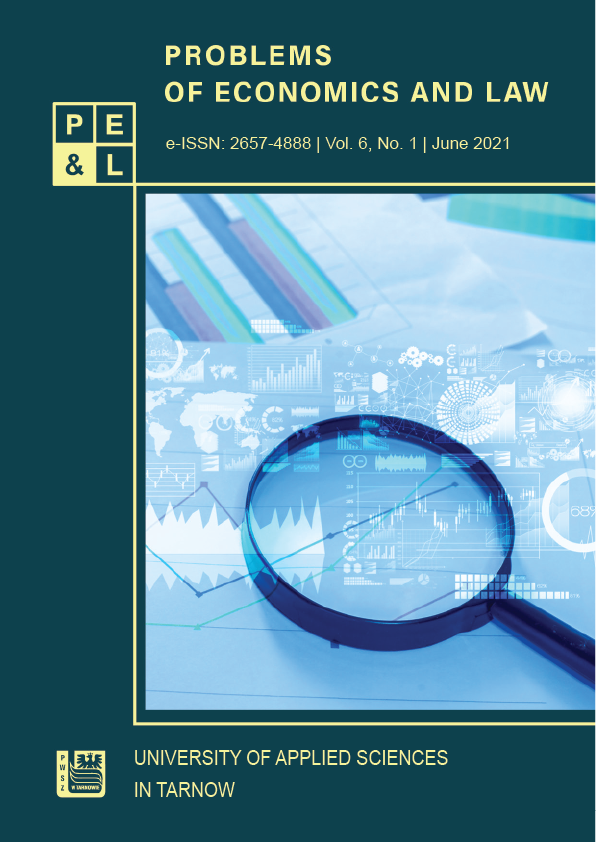Undisclosed sources of revenues as a dimension of the shadow economy in Poland
DOI:
https://doi.org/10.5604/01.3001.0015.6834Keywords:
undisclosed revenues, shadow economy, tax control, hidden activitiesAbstract
A way to raise funds for the Treasury is to impose taxes on various types of entities. Taxpayers who avoid paying public levies are a big problem for the economy. Such practice accepts various types of unlawful conduct and identifies itself with hiding the subject of taxation. One of the most common problems for the Polish tax system is: - failure to declare revenues for taxation with the flat-rate income tax on recorded revenues obtained by natural persons, - failure to report revenues for taxation with personal income tax. This article deals with the gray economy caused by the non-disclosure of revenues and taxable income. Based on the analysis of the literature on the subject, reports and statistical data for the years 2016-2020 provided by the Ministry of Finance, the size of the shadow economy related to undisclosed sources of income revealed as a result of tax inspections.
Downloads
References
Cassel D., Caspers A., Was ist Schattenwirtschaft? Begriff und Erscheinungsformen der Sekond Economy, „Wirtschaftswissenschaftliches Studium” 1984, Heft 1, s. 1–7. Google Scholar
Dochody budżetu państwa, https://www.podatki.gov.pl/z-twoich-podatkow/dochody-i-wydatki-ztwoich-podatkow/ [dostęp: 01.11.2021]. Google Scholar
Działalność nierejestrowana. Poradnik praktyczny. Ministerstwo Przedsiębiorczości i Technologii IPAG pokazał szacowany rozmiar szarej strefy w Polsce w 2021 roku, https://www.bankier.pl/wiadomosc/IPAG-pokazal-szacowany-rozmiar-szarej-strefy-w-Polsce-w2021-roku-8079626.html [dostęp: 01.11.2021]. Google Scholar
Działalność nierejestrowana. Poradnik praktyczny. Ministerstwo Przedsiębiorczości i Technologii, październik 2018 r. https://www.gov.pl/documents/910151/911704/dzialalnosc_nierejestrowa.pdf [dostęp: 01.11.2021]. Google Scholar
Dziemianowicz R., Nadmierny fiskalizm: bariera czy stymulator funkcjonowania sektora publicznego?, OPTIMUM – Studia Ekonomiczne nr 4 (40) 2009. Google Scholar
E.L. Feige, The underground economy. Tax evasion and information distortion, Cambridge University Press, 1989, Finanse, Rynki Finansowe, Ubezpieczenia nr 76, t. 1, 2015. Google Scholar
Fundowicz J., Łapiński K., Stefanowicz J., Wyżnikiewicz B., Wyżnikiewicz D., Szara strefa 2021, Instytut Prognoz i Analiz Gospodarczych, 2021. Google Scholar
Gutmann P.M., The Subterranean Economy. Redux [w:] The Economics of the Shadow Economy, red. Gaertner W., Wenig A., Berlin 1985. Google Scholar
Kiedy przedsiębiorca potrzebuje koncesji, zezwolenia lub wpisu do rejestru działalności regulowanej, https://www.biznes.gov.pl/pl/portal/00116 [dostęp: 01.11.2021]. Google Scholar
Malaczewska, P., Szara strefa gospodarki. Determinanty i mechanizmy kształtowania. Wydawnictwo Uniwersytetu Łódzkiego, Łódź 2019. Google Scholar
Mars G., Cheats at Work. An Anthropology of Workplace Crime, London 1984. Google Scholar
Ministerstwo Finansów - Krajowa Administracja Skarbowa, https://www.gov.pl/web/kas/zadania-kas [dostęp: 25.10.2021]. Google Scholar
Pasternak-Malicka M., Szara strefa - definicje, przyczyny, szacunki. Polska perspektywa zjawiska, Studia BAS, Nr 2(58) 2019. Google Scholar
Pauch D., Zjawisko szarej strefy w gospodarce, Zeszyty Naukowe Uniwersytetu Szczecińskiego nr 864. Google Scholar
Piecuch T., & Szczygieł E., Przedsiębiorczość szarej strefy. Roczniki Ekonomii i Zarządzania, 10(2), (2018), s. 95-107. Google Scholar
Rozporządzenie Parlamentu Europejskiego i Rady (UE) nr 549/2013 z 21 maja 2013 r. w sprawie europejskiego systemu rachunków narodowych i regionalnych w Unii Europejskiej, Dz.Urz. UE L 174 z 26 czerwca 2013 r. Google Scholar
Schneider F., Williams C., The Shadow Economy, Institute of Economic Affairs, Profile Books, Ltd. – Hobbs the Printers, London 2013. Google Scholar
Tanzi V., The Underground Economy in the United States and Abroad, LexingtonBooks D.C. Heath and Company, 1982. Google Scholar
Ustawa z dnia 26 lipca 1991 r. o podatku dochodowym od osób fizycznych (t.j. Dz.U z 2021 poz.1128). Google Scholar
Wyżnikiewicz B., Fundowicz J., Łapiński K., Szara strefa, IPAG, Warszawa 2018. Google Scholar
Wzrost fiskalizmu w Polsce oraz UE, https://alebank.pl/w-polsce-fiskalizm-wzrosl-szybciej-nizsrednio-w-unii-europejskiej/?id=302466&catid=25926 [dostęp:31.10.2021]. Google Scholar
Zarzecki J., Fiskalizm i polityka rynku pracy. Wybrane problemy z finansów cz. II, Sopocka Szkoła Wyższa, 2014. Google Scholar
Downloads
Published
How to Cite
Issue
Section
License
Copyright (c) 2021 University of Applied Sciences in Tarnow, Poland & Authors

This work is licensed under a Creative Commons Attribution-ShareAlike 4.0 International License.





